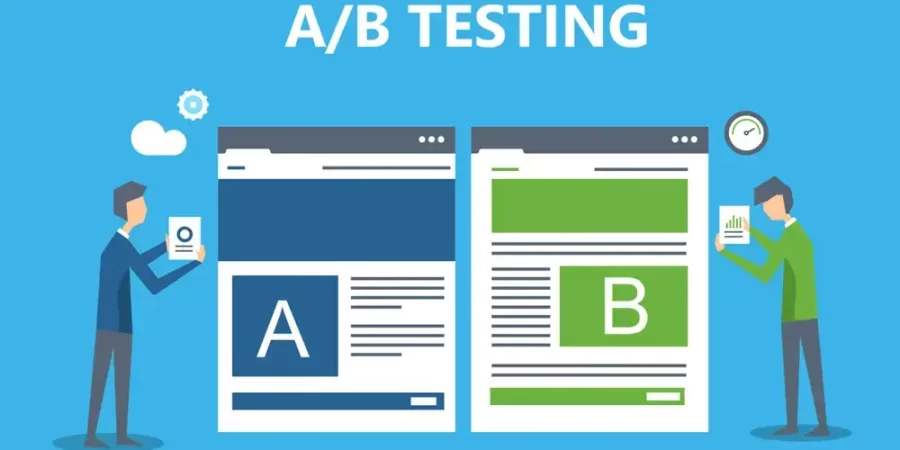Beginners Guide: What Is A/B Testing And Why Is It Important?
A/B testing, also known as split testing or bucket testing, is a method of comparing two versions of a website or app against each other to determine which one performs better. It is a way to experiment with different design or copy elements, in order to optimize the user experience and increase conversions.
A/B testing is important because it allows businesses and organizations to make data-driven decisions about their digital products. Rather than relying on intuition or assumptions, A/B testing allows you to collect real-world data and use it to make informed decisions about what changes will have the biggest impact on your metrics.
One of the key advantages of A/B testing is that it allows you to test specific hypotheses. For example, you may have a hypothesis that a certain color change on your website’s “Buy” button will increase conversions. By setting up an A/B test, you can randomly assign a portion of your website visitors to see the original button color, and another portion to see the new color. By measuring the conversion rates for each group, you can determine if the color change had a positive or negative effect on conversions.
Another advantage of A/B testing is that it allows you to test multiple variables at once. This is known as multivariate testing. This can be especially useful for more complex changes, such as redesigning a homepage or checkout flow. By testing multiple elements of a design at once, you can identify which specific changes are driving improvements in your metrics.
A/B testing is also important because it allows you to test changes on a small scale before rolling them out to the entire user base. This is known as “testing in production.” This approach allows you to quickly iterate on changes, and to roll back any changes that have a negative impact on your metrics.
A/B testing can be used to test a wide range of digital products, including websites, mobile apps, and email campaigns. It can be used to optimize a wide range of metrics, including conversion rates, bounce rates, and customer engagement.
One of the most common mistake when doing A/B testing is to not run the test for long enough. A/B testing requires a significant amount of data to produce accurate results. A test that runs for only a day or two may not provide enough data to draw statistically significant conclusions. It’s important to run the test for a sufficient amount of time, usually at least a week, to ensure that you have enough data to make accurate conclusions.
Another common mistake is to not have a clear hypothesis or test plan. Before starting an A/B test, it’s important to have a clear idea of what you’re trying to accomplish, and what specific changes you’re testing. Without a clear hypothesis or test plan, it can be difficult to know what changes are driving improvements in your metrics.
A/B testing is a powerful method for optimizing digital products and making data-driven decisions. It allows you to test specific hypotheses and multiple variables at once, and to test changes on a small scale before rolling them out to the entire user base. By avoiding common mistakes and running your tests for a sufficient amount of time, you can use A/B testing to improve your conversion rates, engagement and other metrics, ultimately leading to better user experience and increased revenue.
Additionally, A/B testing is valuable because it provides a way to measure the impact of changes that are made to a website or app. This allows businesses and organizations to make informed decisions about which changes are most effective in achieving their goals.
A/B testing can also be used to test different marketing campaigns. For example, you can use A/B testing to compare the effectiveness of different email subject lines or ad headlines. This can help you to identify which messages are most likely to be read and acted upon by your target audience.
Another important aspect of A/B testing is that it allows for the continuous optimization of a website or app. As new data is collected and analyzed, businesses can continue to make changes and test them to see if they have a positive impact. This approach allows for a website or app to be continuously improved over time, leading to a better user experience and higher conversion rates.
There are several tools and platforms available that can be used to conduct A/B testing. Some popular options include Optimizely, Google Optimize, and VWO. These tools provide a user-friendly interface that allows businesses and organizations to set up and run A/B tests with minimal technical expertise.
However, it’s important to note that A/B testing is not a one-size-fits-all solution. It’s important to consider the context of your business and your target audience when deciding what changes to test. For example, A/B testing may not be the best approach for testing major redesigns or changes to the overall user flow. In these cases, it may be more appropriate to conduct user research, such as usability testing, to gather more in-depth insights about how users interact with your website or app.
A/B testing is a powerful tool for improving the performance of digital products. It allows businesses and organizations to make data-driven decisions about changes to their websites and apps, leading to better user experience, higher conversion rates, and ultimately, increased revenue. By combining A/B testing with other user research methods, businesses can gain a deeper understanding of their users and create digital products that meet their needs and goals.
Here are some bullet points to help you with A/B Testing for success:
- A/B testing, also known as split testing or bucket testing, is a method of comparing two versions of a website or app against each other to determine which one performs better.
- It is a way to experiment with different design or copy elements, in order to optimize the user experience and increase conversions.
- A/B testing is important because it allows businesses and organizations to make data-driven decisions about their digital products, rather than relying on intuition or assumptions.
- A/B testing allows you to test specific hypotheses, such as a color change on a website button to increase conversions.
- A/B testing allows for testing multiple variables at once, this is known as multivariate testing, useful for complex changes such as redesigning a homepage.
- A/B testing allows for testing changes on a small scale before rolling out to the entire user base, this is known as “testing in production”
- A/B testing can be used to test a wide range of digital products, including websites, mobile apps, and email campaigns.
- A/B testing can be used to optimize a wide range of metrics, including conversion rates, bounce rates, and customer engagement.
- A/B testing requires a significant amount of data to produce accurate results. A test that runs for only a day or two may not provide enough data to draw statistically significant conclusions, therefore it’s important to run the test for a sufficient amount of time, usually at least a week.
- A/B testing requires a clear hypothesis or test plan, without it, it can be difficult to know what changes are driving improvements in your metrics.
- A/B testing allows for the continuous optimization of a website or app as new data is collected and analyzed, leading to a better user experience and higher conversion rates.
- There are several tools and platforms available that can be used to conduct A/B testing, such as Optimizely, Google Optimize, and VWO.
- A/B testing is not a one-size-fits-all solution, it’s important to consider the context of your business and your target audience when deciding what changes to test.
- A/B testing can be combined with other user research methods, such as usability testing, to gain a deeper understanding of users and create digital products that meet their needs and goals.
In summary, A/B testing is a powerful and essential tool for optimizing digital products and making data-driven decisions. It provides a way to test specific hypotheses, multiple variables, and make changes on a small scale before rolling them out to the entire user base.
By conducting A/B tests, businesses and organizations can identify the changes that will have the biggest impact on their metrics and improve their user experience, conversion rates, and ultimately, their bottom line. With the availability of user-friendly tools, A/B testing is now more accessible and easy to implement, making it a must-have for any organization looking to improve their digital product’s performance.





Leave a Reply